The Groove-billed Ani (Crotophaga sulcirostris) is captivating with its distinctive features, making it a standout presence in the avian world. This medium-sized bird is renowned for its uniquely serrated bill, adorned with transverse grooves.
Found in diverse habitats spanning from the southern United States to South America, the Groove-billed Ani showcases adaptability. The striking contrast of its reddish eyes against the black plumage adds to its visual allure.
However, it’s not just their appearance that intrigues them; Groove-billed Anis engage in cooperative breeding, constructing communal nests, and displaying social behaviors.
As adept insectivores with a penchant for mimicry, these birds offer a fascinating blend of characteristics, making them a captivating subject for bird enthusiasts and nature lovers alike. Stay sharp.
Pick Out Characteristics of Groove-billed Ani
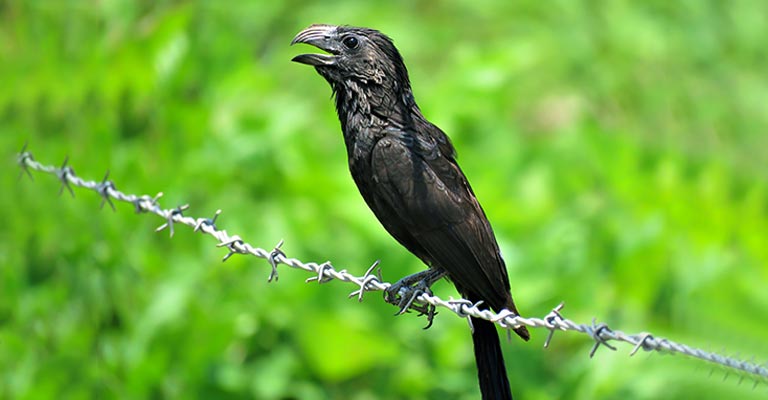
The Groove-billed Ani (Crotophaga sulcirostris) is a unique and intriguing bird native to the Americas, known for its distinct appearance and behaviour.
Identifying this species requires a keen eye and attention to specific characteristics, as outlined below in some key points.
Distinctive Bill Structure
One of the most notable features of the Groove-billed Ani is its bill. The upper mandible of the bill possesses distinct transverse grooves, a defining characteristic that sets it apart from other birds.
The grooves give the bill a serrated appearance, making it easily recognizable.
Medium-sized Bird
The Groove-billed Ani is a medium-sized bird with an overall length of around 12 to 14 inches (30 to 36 centimeters). Its slender body has a long tail, contributing to its sleek and agile silhouette.
Black Plumage
The plumage of the Groove-billed Ani is predominantly black, creating a sleek and glossy appearance.
The black coloration extends across its entire body, including the wings and tail. This uniform coloring aids in distinguishing it from other avian species.
Reddish Eye
The bird’s eye is distinctively reddish, providing a striking contrast against its black plumage. This eye coloration is a helpful identification feature, especially when observing the bird from a distance.
Long Tail
The Groove-billed Ani has a relatively long and graduated tail, which adds to its distinctive profile.
The tail feathers are black, matching the overall coloration of the body, and the length of the tail contributes to the bird’s agile and acrobatic flight.
Social Behavior
This species is often observed in groups or flocks. The social behavior of Groove-billed Anis is noteworthy, as they are known to engage in cooperative breeding, with multiple individuals contributing to the care and protection of the young.
Distinctive Vocalizations
Identifying the Groove-billed Ani can also be accomplished through its unique vocalizations. The bird produces a variety of calls, including a low, guttural croaking sound.
These vocalizations are often heard within the group and can help locate their presence in the vicinity.
Habitat Preferences
Groove-billed Anis inhabit various habitats, including grasslands, open woodlands, and scrublands.
They are particularly fond of areas with dense vegetation where they can forage for insects and small vertebrates. Observing their habitat preferences can aid in identifying these birds in the wild.
The Groove-billed Ani stands out in the avian world due to its unique bill structure, black plumage, reddish eye, and distinctive vocalizations.
Paying attention to these critical characteristics, social behavior, and habitat preferences provides a comprehensive guide for birdwatchers and enthusiasts seeking to identify this fascinating species in their natural environment.
Taxonomy of Groove-billed Ani
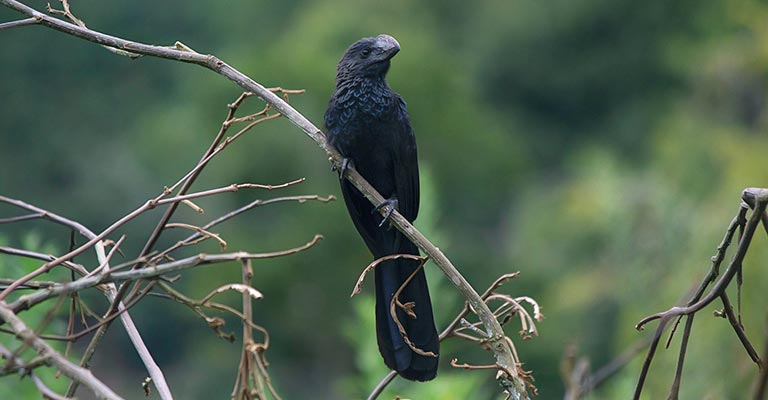
Check out the following table that showcases all the taxonomy details of the Groove-billed Ani:
| Taxonomic Level | Classification |
| Domain | Eukaryota |
| Kingdom | Animalia |
| Phylum | Chordata |
| Class | Aves |
| Order | Cuculiformes |
| Family | Cuculidae |
| Genus | Crotophaga |
| Species | C. sulcirostris |
The Groove-billed Ani (Crotophaga sulcirostris) belongs to the family Cuculidae, commonly known as cuckoos. It is a member of the genus Crotophaga, including others and species.
The cuckoo family is characterized by medium to large-sized birds with slender bodies, long tails, and distinctive bills. Within the order Cuculiformes, Groove-billed Anis are part of the subfamily Crotophaginae.
Their taxonomy places them among the diverse cuckoos, known for their varied habitats, vocalizations, and unique breeding behaviours, contributing to the rich tapestry of avian biodiversity.
Hunting Habit of Groove-billed Ani
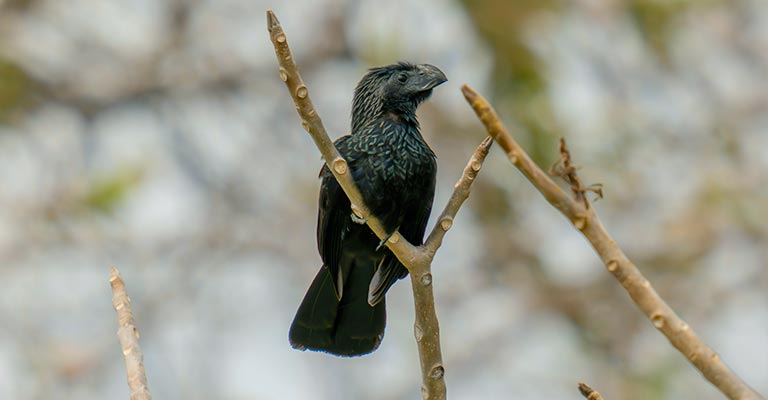
The Groove-billed Ani (Crotophaga sulcirostris) exhibits distinctive hunting habits contributing to its survival and dietary preferences.
Primarily an insectivore, the ani forages on the ground and low vegetation for a diverse array of invertebrates, including insects and small reptiles.
Its specialized bill, characterized by transverse grooves, is adapted for capturing and consuming a variety of prey. The ani employs a cooperative hunting strategy, often seen in small groups or flocks, where individuals work together to locate and flush out insects.
This social behaviour extends to the feeding process, with multiple birds simultaneously converging on a food source. Additionally, the Groove-billed Ani is known to consume fruits and seeds, broadening its diet.
Its hunting habits blend individual foraging and cooperative efforts, showcasing adaptability in securing diverse food resources.
Groove-billed Ani Life History
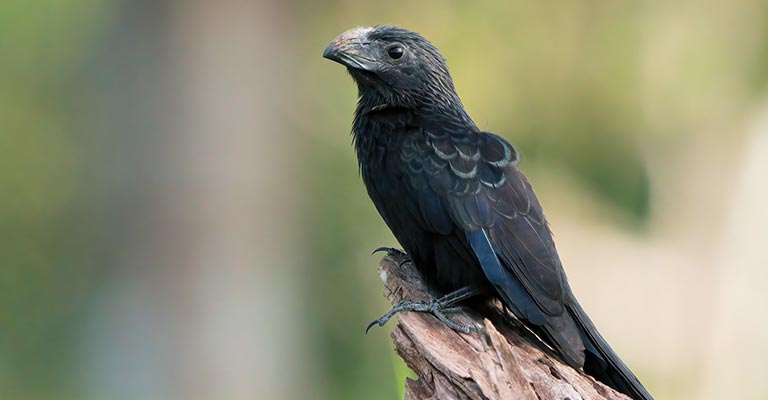
The Groove-billed Ani (Crotophaga sulcirostris) is a captivating bird with unique characteristics that define its life history.
From its feeding habits to nesting behaviour and range, the Groove-billed Ani’s life is a testament to its adaptability and cooperative living.
Food
Groove-billed Anis subsists on an insect-rich diet, including various invertebrates and small reptiles. Their specialized bill, with transverse grooves, aids in capturing and consuming a diverse array of prey.
In addition to insects, these birds supplement their diet with fruits and seeds, showcasing dietary flexibility.
Habitat
These birds are versatile in their habitat preferences, inhabiting grasslands, open woodlands, and scrublands. They thrive in areas with dense vegetation, providing ample foraging opportunities.
The Groove-billed Ani’s adaptability to different environments contributes to its widespread distribution.
Range Map

The Groove-billed Ani’s range extends from the southern United States through Central America to South America, covering regions with suitable climates and vegetation.
A range map illustrates their migratory patterns and the various ecosystems they inhabit.
Nesting
Groove-billed Anis are cooperative breeders, with multiple individuals participating in nesting activities. They construct bulky, communal nests of twigs and vegetation in dense shrubs or trees.
The nests are often located close to each other, emphasizing the social nature of their breeding behaviour.
Here is a table outlining the nesting details of the Groove-billed Ani:
| Nesting Details | Facts |
| Clutch Size | 3 to 6 eggs |
| Number of Broods | Usually 1 per breeding season |
| Egg Length | Approximately 2.5 centimeters (1 inch) |
| Egg Width | Around 2 centimeters (0.8 inches) |
| Incubation Period | Approximately 13 to 15 days |
| Nestling Period | About 10 to 12 days |
| Egg Description | Oval-shaped, smooth surface, pale blue-green |
| Nest Construction | Communal nests made of twigs and vegetation |
| Nest Location | Dense shrubs or trees in groups |
| Incubation and Care | Shared responsibilities among group members |
| Fledgling Independence | Young birds become independent after fledging |
These nesting details provide insights into the reproductive behaviour and parental care exhibited by the Groove-billed Ani, emphasizing their cooperative breeding strategy and the unique characteristics of their nests and eggs.
Breeding
Breeding in Groove-billed Anis typically occurs during the warmer months. The cooperative breeding strategy involves shared responsibilities in incubating eggs and caring for the young.
This social structure contributes to the success and survival of the offspring, highlighting the importance of communal efforts.
Diseases
While the Groove-billed Ani doesn’t exhibit specific susceptibility to diseases, like any wildlife species, they may face threats from pathogens and environmental factors.
Monitoring for avian diseases, particularly those affecting communal nesting sites, is essential for their overall health and population stability.
Treatment
Effective treatment of diseases in Groove-billed Anis involves a combination of monitoring, research, and conservation efforts.
Understanding potential threats and implementing measures to mitigate disease spread, such as maintaining habitat health and reducing human-induced stressors, is crucial for their well-being.
Conservation
The conservation status of Groove-billed Anis varies across their range. While they are not currently considered globally threatened, localized declines may occur due to habitat loss and degradation.
Conservation initiatives should focus on preserving their diverse habitats, minimizing human disturbances, and raising awareness about the importance of these unique birds in maintaining ecosystem balance.
The life history of the Groove-billed Ani is a fascinating tale of adaptability, cooperation, and resilience.
From their feeding habits to breeding strategies and conservation needs, understanding the intricacies of their lives is crucial for ensuring the continued existence of this remarkable species.
10 Fun Facts About Groove-billed Ani
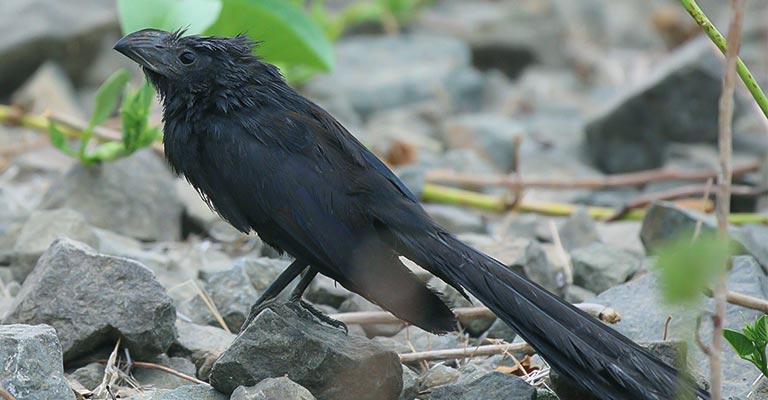
The Groove-billed Ani (Crotophaga sulcirostris) is a charismatic bird with fascinating features that make it stand out among avian species.
Here are 10 fun facts about the Groove-billed Ani that showcase its unique characteristics and behaviours.
- Serrated Bill: The Groove-billed Ani boasts a distinctive bill with transverse grooves, giving it a serrated appearance. This specialized feature aids in capturing a variety of prey, showcasing its adaptability as an insectivore.
- Communal Nests: Unlike many bird species, Groove-billed Anis engage in cooperative breeding, constructing bulky communal nests made of twigs and vegetation. These nests are often located close to each other, highlighting their social nature.
- Vocal Mimicry: Groove-billed Anis are known for their vocal abilities, mimicking the calls of other birds. This behaviour is especially pronounced during the breeding season when they engage in a symphony of diverse sounds.
- Reddish Eye Color: The striking reddish colouration of their eyes adds a vibrant touch to their overall appearance. This feature creates a captivating contrast against their predominantly black plumage.
- Social Foraging: Groove-billed Anis prefer social foraging, often seen in groups or flocks. This cooperative behaviour allows them to effectively locate and flush out insects from the vegetation, showcasing their teamwork in acquiring food.
- Wide Distribution: Their range spans the southern United States through Central America to South America. This wide distribution demonstrates their adaptability to various ecosystems and climates.
- Unique Breeding Strategy: The Groove-billed Ani’s breeding strategy involves multiple individuals caring for the young, showcasing a communal approach to parenting. This cooperative effort enhances the chances of offspring survival.
- Versatile Diet: While primarily insectivorous, Groove-billed Anis also includes fruits and seeds. This dietary versatility contributes to their ability to thrive in different habitats.
- Long Tail Acrobatics: The bird’s long and graduated tail enhances its agility in flight. Groove-billed Anis often engage in acrobatic manoeuvres, showcasing their prowess in the air.
- Notable Nesting Sites: Their nests, constructed in dense shrubs or trees, create a fascinating communal living arrangement. The proximity of nests and shared responsibilities during incubation and care exemplify their unique nesting habits.
Wrapping Up
So, the Groove-billed Ani emerges as a remarkable avian species, uniquely defined by its serrated bill, cooperative breeding, and social behaviours.
From the striking reddish eyes to the acrobatic flights and diverse vocalizations, this bird offers a captivating glimpse into the intricacies of nature.
Its adaptability, wide distribution, and versatile diet underscore the significance of understanding and conserving this charismatic species. Thank you very much.